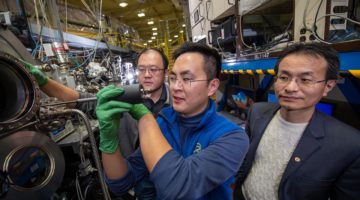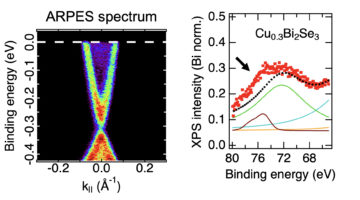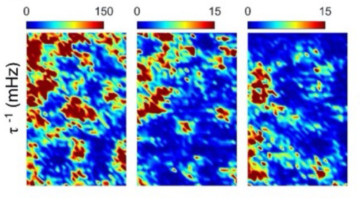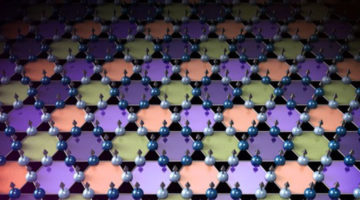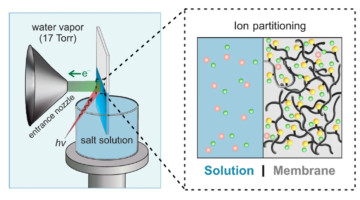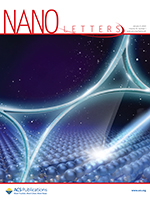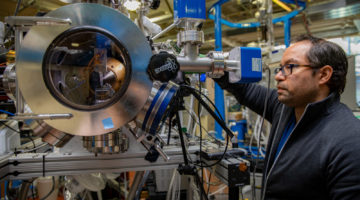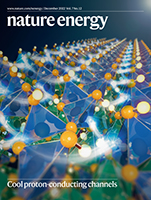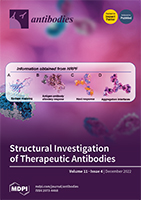Scientists know that copper has a special ability to transform CO2 into valuable chemicals and fuels. But for many years, they struggled to understand how. Now, a research team has gained new insight by capturing real-time movies of copper nanoparticles as they convert CO2 and water into renewable fuels and chemicals: ethylene, ethanol, and propanol, among others. Read more »
Copper Migrates to Surface of Topological Insulator in Air
An ambient-pressure study of a topological insulator doped with copper revealed that the copper atoms, inserted between the material’s layers, migrate to the surface when exposed to air. The work represents a novel way of modifying the material’s surface composition, which can confer it with new properties such as superconductivity. Read more »
ALS in the News (January 2023)
-
-
-
- New ‘chain mail’ material of interlocking molecules is tough, flexible and easy to make
- Journal of Vacuum Science & Technology A publishes special issue commemorating career of David Arthur Shirley
- ALS user Grace Pan wins Malvern Panalytical Scientific Award 2022
- Printed organic solar cells: Research team from the University of Bayreuth involved in new DFG research group
- Kerfeld to lead new DOE-funded Center for Catalysis in Biomimetic Confinement
- UCLA-led research unearths obscure heat transfer behaviors
-
-
Percolating Puddles in Rich Quantum Landscapes
Combining x-ray photon correlation spectroscopy (XPCS) with scanning micro x-ray diffraction (SµXRD), researchers found that charge density wave domains (known as “puddles”) in a nickelate material exhibit two types of dynamics: small puddles actively “percolate” (fluctuate in size and shape), while large puddles are more static. Read more »
Charge Density Wave Found in Magnetic Kagome Crystal
Researchers discovered a wave-like charge order in a magnetic material with a “kagome” geometric structure and obtained clues to the order’s origins in the material’s electronic structure. By helping to connect certain structures with emergent quantum properties, the work brings us a step closer to the goal of creating materials by design. Read more »![]()
![]()
First Direct Measurement of Elusive Donnan Potential
Researchers performed the first direct measurement of the Donnan electrical potential, which arises from an imbalance of charges at membrane-solution interfaces. Considered unmeasurable for over a century, the Donnan potential is relevant to a wide range of fields, from cell biology to energy storage and water desalination. Read more »![]()
![]()
Dirac Nodal Line in Hourglass Semimetal Nb3SiTe6
Hourglass fermion in an electronic band structure is protected by the nonsymmorphic symmetry of a layered semimetal Nb3SiTe6. Angle-resolved photoemission spectroscopy demonstrates the band features of an hourglass fermion in k-space, such as band crossings and nodal loops. Read more »
The Donnan Potential, Revealed at Last
Researchers at the ALS recently led the first direct measurement of the Donnan potential, an electric potential that arises from an imbalance of charges at the interface of a charged membrane and a liquid. The work could yield new insights in areas such as ion transport through cellular membranes, ion exchange membranes in energy storage strategies, and water purification technologies. Read more »
Enhanced low-temperature proton conductivity in hydrogen-intercalated brownmillerite oxide
Solid oxide materials typically need high temperatures to allow appreciable ion transport, limiting their flexibility as electrolytes for energy devices. Lu et al. now show unusually high proton conductivity in a hydrogenated oxide between 40 °C and 140 °C, which they attribute to ordered vacancy channels and high proton concentrations. Read more »
Structural Investigation of Therapeutic Antibodies Using Hydroxyl Radical Protein Footprinting Methods
Well-known high-resolution structural methods are often used to characterize antibody structures, but many require specialized sample preparation that may perturb antibody structure. We describe here the relatively new method of hydroxyl radical protein footprinting, a solution-state method that can provide structural and kinetic information on antibodies or antibody–antigen interactions useful for therapeutic antibody design. Read more »
- « Previous Page
- 1
- …
- 17
- 18
- 19
- 20
- 21
- …
- 83
- Next Page »
